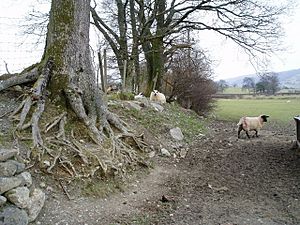Tudur Penllyn facts for kids
Tudur Penllyn was a famous Welsh poet. He lived a long time ago, from about 1420 to 1490. He was one of the "Beirdd yr Uchelwyr," which means "Poets of the Nobility." These were professional poets in Wales during the late Middle Ages.
Contents
Who Was Tudur Penllyn?
His Early Life
Tudur's exact birthplace is not known. But he probably grew up in an area called Penllyn. This area is near Llandderfel in Merioneth. His name "Penllyn" was a special poet's name, not his family name. His full name was Tudur ap Ieuan ap Iorwerth Foel.
We don't know much about his early family. But he came from a family of minor gentry. This means they were a bit like local landowners. As an adult, Tudur lived in a place called Caer-Gai. This was in the parish of Llanuwchllyn. The old manor house where he lived is still a farm today.
Life as a Poet and Trader
Tudur lived during a time called the Wars of the Roses. This was a big fight between two powerful families in England. Many of the noble people who supported Tudur's poetry were on the side of the Lancastrian family.
Tudur traveled all over Wales as a poet. He also worked as a drover. This means he moved sheep and other animals from place to place. He also traded wool. He sold the wool from his sheep in English markets.
Another poet named Guto'r Glyn was Tudur's friend. Guto once wrote a funny poem about Tudur. This was after Tudur didn't help him with a difficult droving trip. Guto's poem also said that Tudur had long hair!
What He Wrote About
Many of Tudur Penllyn's poems still exist today. They show that he wrote about different things. Some poems praised noblemen who fought against the English. Other poems were about religion. These included poems asking for forgiveness. He also wrote poems praising holy places. Some of his poems were about life and its challenges.
His Family
Tudur was married to a woman named Gwerful Fychan. She was also a poet! Their son, Ieuan ap Tudur Penllyn, also became a poet. So, poetry ran in their family!
See also
- Tudur Penllyn at Wikisource


